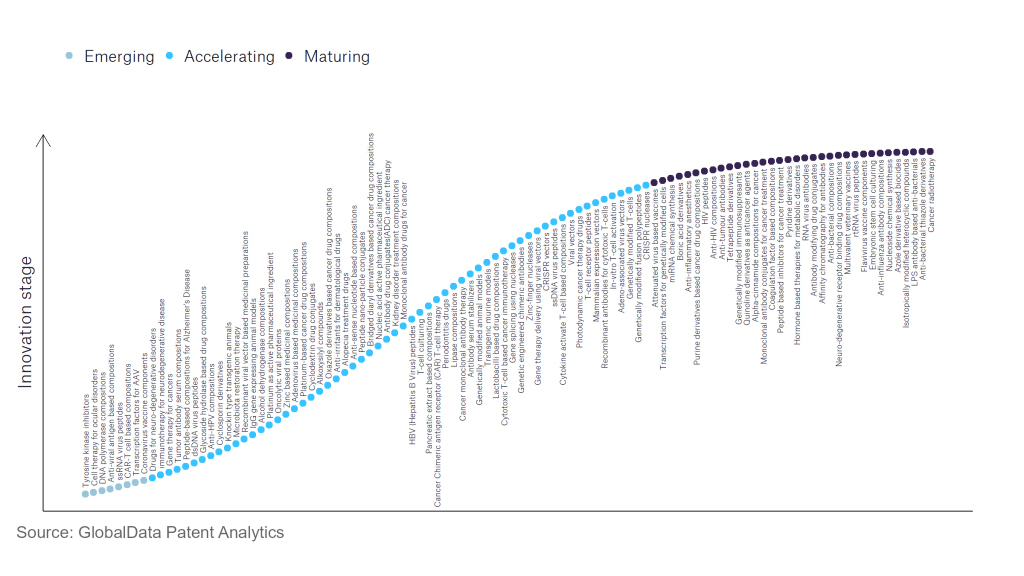The pharmaceutical industry continues to be a hotbed of innovation, with activity driven by the evolution of new treatment paradigms, and the gravity of unmet needs, as well as the growing importance of technologies such as pharmacogenomics, digital therapeutics, and artificial intelligence. In the last three years alone, there have been over 633,000 patents filed and granted in the pharmaceutical industry, according to GlobalData’s report on Innovation in Pharmaceuticals: immunotherapy for neurodegenerative disease. Buy the report here.
However, not all innovations are equal and nor do they follow a constant upward trend. Instead, their evolution takes the form of an S-shaped curve that reflects their typical lifecycle from early emergence to accelerating adoption, before finally stabilising and reaching maturity.
Identifying where a particular innovation is on this journey, especially those that are in the emerging and accelerating stages, is essential for understanding their current level of adoption and the likely future trajectory and impact they will have.
110 innovations will shape the pharmaceutical industry
According to GlobalData’s Technology Foresights, which plots the S-curve for the pharmaceutical industry using innovation intensity models built on over 756,000 patents, there are 110 innovation areas that will shape the future of the industry.
Within the emerging innovation stage, cell therapy for ocular disorders, coronavirus vaccine components, and DNA polymerase compositions are disruptive technologies that are in the early stages of application and should be tracked closely. Adeno-associated virus vectors, alcohol dehydrogenase compositions, and antibody serum stabilisers are some of the accelerating innovation areas, where adoption has been steadily increasing. Among maturing innovation areas are anti-influenza antibody compositions and anti-interleukin-1, which are now well established in the industry.
Innovation S-curve for the pharmaceutical industry

Immunotherapy for neurodegenerative diseases is a key innovation area in pharmaceutical drug development
Neurodegenerative diseases occur when nerve cells in the brain or peripheral nervous system lose function over time and ultimately die. These include diseases such as Alzheimer's disease, Parkinson’s disease, Huntington's disease etc. There are treatments options which may provide temporary relief or slow down the progression of the disease, but a cure is still in development at large. In recent years, research has been carried out to establish the role of immunotherapeutic agents for either the treatment or management of these diseases. Immunotherapy might be a promising therapeutic approach for neurodegenerative diseases that progress with the accumulation and propagation of toxic protein aggregates.
GlobalData’s analysis also uncovers the companies at the forefront of each innovation area and assesses the potential reach and impact of their patenting activity across different applications and geographies. According to GlobalData, there are 40+ companies, spanning technology vendors, established pharmaceutical companies, and up-and-coming start-ups engaged in the development and application of immunotherapy for neurodegenerative disease.
Key players in immunotherapy for neurodegenerative disease – a disruptive innovation in the pharmaceutical industry
‘Application diversity’ measures the number of different applications identified for each relevant patent and broadly splits companies into either ‘niche’ or ‘diversified’ innovators.
‘Geographic reach’ refers to the number of different countries each relevant patent is registered in and reflects the breadth of geographic application intended, ranging from ‘global’ to ‘local’.
Patent volumes related to immunotherapy for neurodegenerative disease
Source: GlobalData Patent Analytics
Affiris is one of the leading patent filers in immunotherapies for neurodegenerative disease. The company is actively developing new molecules for the treatment of theser central nervous system diseases, including Huntington’s disease. In terms of application diversity, Eli Lilly is the top company, followed by ADEL and Intra-Cellular Therapies. By means of geographic reach, MorphoSys holds the top position. Whilst PT Soho Global Health and German Cancer Research Center are in second and third positions, respectively.
To further understand the key themes and technologies disrupting the pharmaceutical industry, access GlobalData’s latest thematic research report on Pharmaceutical.
Data Insights
From

The gold standard of business intelligence.
Blending expert knowledge with cutting-edge technology, GlobalData’s unrivalled proprietary data will enable you to decode what’s happening in your market. You can make better informed decisions and gain a future-proof advantage over your competitors.



